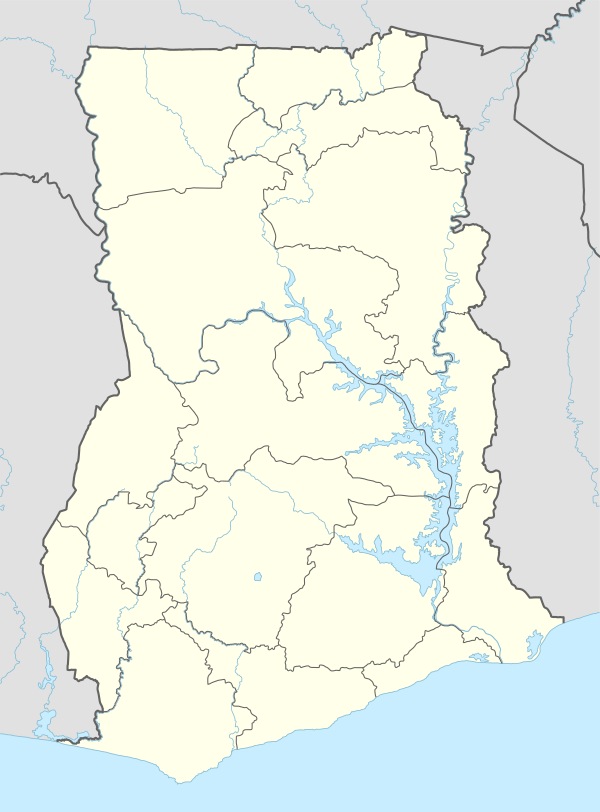Sampa, Ghana
Sampa is a town in the Bono Region of Ghana, on the border with Côte d'Ivoire. It is the capital of Jaman North Municipal, and was formerly the site of a Slave market.[1] It was also the capital of the Akan State of Gyaaman in the late 15th century. It is the biggest border town in Ghana with a population of over 36,000.[2] It is the principal town of the Nafana ethnic group. They speak the Nafaanra language. They equally speak Twi because Sampa is a cosmopolitan society. Nafaanra is also spoken in Banda District, parts of Tain District and Bondoukou District of Cote d'Ivoire. The major cash crop produced by the people is Cashew. It is the leading producer of Cashew in Ghana.
Sampa samgba Sikasoko | |
|---|---|
Urban | |
| Nickname(s): The Border City | |
| Motto(s): Yeyiri Nafana | |
 Sampa Location in Ghana | |
| Coordinates: 7°57′N 2°42′W | |
| Country | |
| Region | Bono Region |
| District | Jaman North Municipal |
History
Sampa is derived from two Nafaanra words; Se (Go) and Pa (Come), when the two words are combined together as 'Sempa', it means, "When you go come back." Sempa has now assumed the orthographic form 'Sampa'. Sampa, capital of the Jaman North Municipal was originally called Sikasoko. It means gold powder. This explains the abundant gold in the area in times past. In 1890s when the British and French colonialists established a boundary between their territories, Sampa which was known as Sikasoko was designated headquarters of the Northwestern Ashanti. Before Sunyani became the capital of the Northwestern Ashanti in 1906, Sampa had served as capital of the district, which comprised Jaman, Wenchi, Techiman, Berekum, Wam (Dormaa), Ahafo, Odumasi and Sunyani.
The ancestors of Sampa are said to have migrated from Kakala, a village in the Republic of Cote d'Ivoire. The migration was necessitated by the Trans-Saharan trade that was bringing civilization from the south to the North as well as tribal wars in the area at that time. They were led by Tolee Sie Nyonogboo and Tolee Kra Longo. When they arrived at Tampi area, the chief of Jamera invited them to help fight the Klolosa tribe in the neighbourhood. Sie Nyonogboo asked Kra Longo and his team to pass through the Banda hills while he and his team took the west direction. It took Sie Nyonogboo and his men a relatively short time to conquer the Klolosa army around the present-day Debibi and Namasa area. After the war, a parcel of land being occupied by the chiefs and people of Sampa today was offered as reward for the role in the war and to further prevent the Klolosa people from attacking Jamera. Elders of Sampa explain that during the Trans-Saharan trade period, merchants from the south used to ply the main route that passed through Sampa to northern Africa. When they arrived at Sampa, they met the indigenes that wore cloth, a practice, which was not common at the time. The merchants preferred to say they were travelling to the land of the cloth-wearing people(Firantoma fo), instead of the specific name of their destination. The word 'Firantoma fo' has been corrupted to 'Fantra fo' by their Bono neighbours, though the people of Sampa find the name 'Fantra fo' as pejorative.
Sampa served also as an important centre during the Slave trade era. Bones of the countless slaves damped in a mass grave are still visible at a spot in a town of Jenini near Sampa. Other items of historical interest in Sampa include the bungalows of the expatriate administrators, a ruined chapel of the Presbyterian Church and a cemetery of the colonial administrators with toms that date back to the 19th century.
Festivals
The two main annual festivals of the royal Stool of Sampa are the Songbee and Dwobofie. The former is celebrated in the latter part of June or July to commemorate the life and works of the ancestors. A highlight of this festival is wrestling competition among the youth. Dwobofie is held in September to usher in the eating of new yam. It is a taboo for the Omanhene (Paramount chief) to eat yam before the festival.
Education
Several senior high and technical schools can be found within Sampa and its suburbs. This include Nafana Presby Senior High which is rated among the best schools in Ghana. Others are St. Ann's Girls Senior High School, Our Lady Of Fatima Vocational Training Institute, Maranatha Business Senior High School, Diamono Senior High and Duadaso No. 1 Senior High/Technical school. Sampa is also the home of the Sampa Nurses' Training College.
Health
Sampa has the Sampa Government Hospital which is a district hospital to support nursing training at the Sampa Nurses' Training College. Several other private hospitals and clinics operate in Sampa. Recommended private medical facilities are the Pieta Hospital, along the Sampa-Kabile road and Fountain Care Hospital, located behind Yankee Radio premises.
Economy
The major economic activities of Sampa fall under agriculture, commerce, industrialization and service. Sampa was formerly a slave market site during the Atlantic slave trade in Africa and contemporary a Cashew market centre in Ghana. Cashew buyers and purchasers from India and Vietnam have their company warehouses in Sampa. These companies have merchants in Bole, Wenchi, Dormaa, Techiman, Banda and the neighbouring Cote d'Ivoire who transport Cashew nuts to Sampa before they are further transported to Tema for export. Again, the Sampa Market is one of the largest in the Bono Region which sees foreigners from Cote d'Ivoire and other regions across the country to engage in buying and selling.
Some notable personalities from Sampa
- Seth Appiah-Mensah
- Siaka Stevens (Ghanaian politician)
References
- "2.3.1 Ghana Border Crossing of Sampa - Logistics Capacity Assessment - Digital Logistics Capacity Assessments". dlca.logcluster.org. Retrieved 2020-04-17.
- "Sampa; My Town, My Tears". Modern Ghana. Retrieved 2020-04-17.